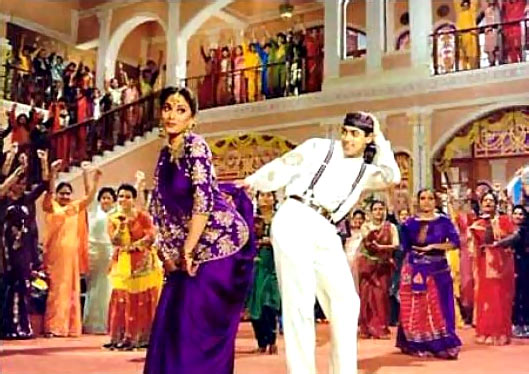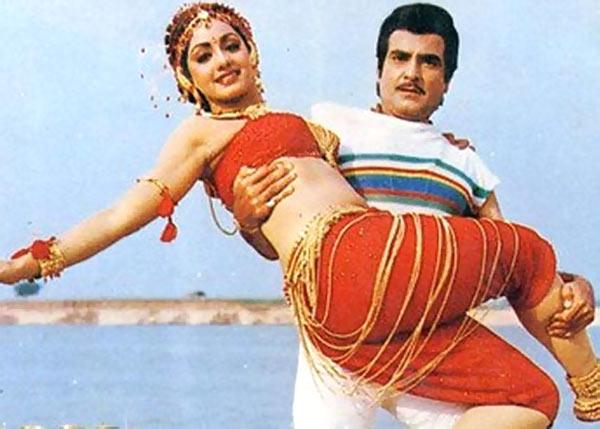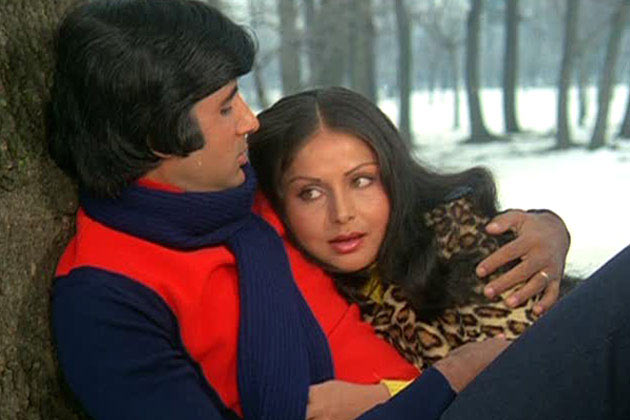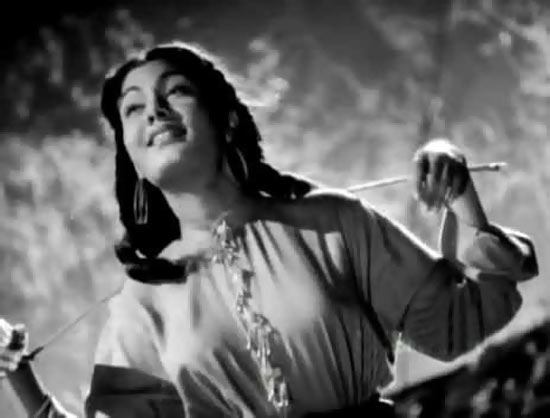The magnitude of Lata Mangeshkar cannot be possibly described in words.
Just imagine brilliance at its finest best and some more and you might just come close to appreciating her influence/embodiment on/as music.
Whether you were born in the 1940s, 50s, 60s, 70s, 80s, 90s or post 2000, there’s no way you’ve not been touched by her soulful voice.
For music lovers, the legend of melody is like the sun whose brightness has not merely enriched their love for music but shaped their taste. Even her harshest critics will not deny her devotion towards her art or the longevity of her career.
The befittingly decorated Nightingale of India and, quite literally, Bharat’s Ratna turns 84 on September 28.
In her enduring journey, the singer has performed in multiple languages, worked with every distinguished composer, sang duets with all the top male playback singers in the industry and embellished the careers of countless beautiful ladies -- new and iconic -- with her inimitable mithaas.
From Madhubala to Madhuri Dixit, we celebrate Lata Mangeshkar -- the voice of seven decades.
2000 onwards
At 70 plus, Mangeshkar’s sonorous timbre had seen better days. But filmmakers insisted on her celebrated voice gracing their movies and her loyal following savored it.
Aishwarya Rai, Rani Mukerji, Kareena Kapoor, Sneha Ullal and Konkona Sen Sharma can count themselves among the lucky few for whom the songstress has sung in her precious few assignments in the past couple of decades.
Though her songs Humko Humise Churalo (Mohabbatein), O Palanhare (Lagaan) Andekhi Anjani Si (Mujhse Dosti Karoge), Kabhi Khushi (Kabhi Khushi Kabhie Gham), Tere Liye (Veer Zaara), Kitne Ajeeb (Page 3) Shayad Yehi Toh (Lucky: No Time For Love), Lukka Chuppi (Rang De Basanti) and Daata Sun Le (Jail) have met with a varying degree of reception, Lata Mangeshkar’s body of work (she's rumoured to have sung a track for Sanjay Leela Bhansali's upcoming epic, Ramleela) is much too vast, awe-inspiring and prized to disregard at any juncture.
The 1990s
Image: Madhuri Dixit and Salman Khan in Hum Aapke Hain Koun...!Steady as a rock, Lata Mangeshkar's intense riyaaz paid off as she was now singing for children of her 1960s heroines like Tanuja and Babita.
The gorgeous soundtrack of Maya Memsaab, helmed by her younger brother Hridayanath, along with Gulzar’s Lekin and Kalpana Lajmi’s Rudaali provided a breath of fresh air in a noise of synthetic music with melodies like Ek Haseen Nigah, Yaara Silli Silli and Dil Hoom Hoom respectively.
Even her commercial songs fared superbly on the charts.
Whether conveying Raveena Tandon’s roller-skating enthusiasm in Tumse Jo Dekhte (Patthar Ke Phool), Zeba Bakhtiar’s longings in Chitthiye (Henna), Juhi Chawla’s dreamy inclinations in Tu Mere Saamne (Darr), Sridevi’s desert serenade in Morni Baaga Ma (Lamhe), Manisha Koirala’s understated elegance in Kuch Na Kaho (1942: A Love Story), Mamta Kulkarni’s temptress act in Ek Munda (Karan Arjun), Tabu’s solitary gloom in Paani paani re (Maachis), Urmila Matondkar’s monsoon mania in Geela Geela Pani (Satya) or rocking back-to-back blockbusters with Madhuri Dixit’s Didi Tera Devar (Hum Aapke Hain Koun…!) and Kajol’s Mere Khwabon Mein Jo (Dilwale Dulhania Le Jayenge).
With Dil Se’s Jiya Jale picturised on Preity Zinta and So Gaye Hain in Karisma Kapoor’s career best Zubeidaa, the singer showcased a refreshing facet of her range against A R Rahman’s rousing score.
The 1980s
Image: Sridevi and Jeetendra in HimmatwalaThe middle-aged Lata Mangeshkar shows no signs of fatigue. Though her voice is golden as ever, she is decidedly choosier about her assignments.
Though it’s one of the most wanting decade of Bollywood music, Mangeshkar has quite a few memorable chartbusters to her credit.
Let’s see: Sheesha ho ya dil, Aasha, Na koi umang, Kati Patang, Teri yaad, Love Story, Hai woh pardesi, Barsaat Ki Ek Raat, Main solah baras ki, Karz, Mere naseeb mein, Naseeb, Tune o rangeele, Kudrat, Megha chhaye aadhi raat, Sharmilee, Aye ri pawan, Bemisaal, Yeh galiyan yeh chaubara, Prem Rog, Tere mere beech mein, Ek Duuje Ke Liye, Yeh kahan aa gaye hum, Silsila, Aye dil-e-nadaan, Razia Sultan, Tujhse naraaz, Masoom, Naino mein sapna, Himmatwala, Nindiya se jaagi bahar, Hero, Jab hum jawan honge, Betaab, Kahin na ja, Bade Dilwala, Sagar kinare, Sagar, Zindagi pyaar ka geet, Souten, Mann kyo behka, Utsav, Zihale muskin, Ghulami, Sun sahiba, Ram Teri Ganga Maili, Dushman na kare, Aakhir Kyon, Silli hawa, Libaas, Bada dukh dina, Ram Lakhan, Dil deewana, Maine Pyaar Kiya and Mere haathon mein, Chandni.
Whoa, right?
That’s Lata-tai for you.
Her extensive work gives the stars of this decade like -- Reena Roy, Vijeta Pandit, Rati Agnihotri, Padmini Kolhapure, Zarina Wahab, Sridevi, Neetu Singh, Smita Patil, Amrita Singh, Meenakshi Seshadri, Anita Raj, Mandakini, Neelam, Farha, Madhuri Dixit and Bhagyashree some of the most notable songs of their career.
The 1970s
Image: Amitabh Bachchan and Rakhee in Kabhi KabhieWho can forget her precise anguish for Waheeda Rehman’s teary-eyed Rangeela re (Prem Pujari) or Leela Chandravarkar’s smiling cynicism in Jaane kyon log mohabbat (Mehboob Ki Mehendi), Priya Rajvansh’s curious observations in Milo na tum toh (Heer Ranjha), Mumtaz’s lilting eee’s in Aye maine kasam li (Tere Mere Sapne), Nanda’s philosophical reflections in Ek pyar ka nagma hai (Shor), Sharmila Tagore’s poignant sentiments in Raina beeti jaaye (Amar Prem), Suchitra Sen’s profound realization in Tere bina zindagi (Aandhi), Raakhee’s unforgettable luminosity in Kabhi kabhi (Kabhi Kabhie), Hema Malini’s puzzling woes in Mere naina sawaan bhadon (Mehbooba), Moushumi Chatterji’s sublime revelry in Rimjhim gire sawaan (Manzil) or Meena Kumari’s delicate allegations in Inhi logon ne (Paakezah)?
Equally incredible is her contribution towards a bright bunch of actresses on the block.
If Dimple Kapadia lip-synced to Hum tum ek kamre mein in Bobby, Poonam Dhillon happily hummed Aaja re in Noorie, Zeenat Aman oozed oomph in her voice for Satyam Shivam Sundaram’s title track whereas Jaya Pradha rejoiced in her Dafliwale dance in Sargam even as Vidya Sinha sparkled via Rajnigandha and Chhoti Si Baat’s title tracks.
Meanwhile, Jaya Bhaduri’s sensible aura found a classic match in Lata Mangeshkar’s rendition of Piya bina (Abhimaan), Roothe roothe piya (Kora Kagaaz)) and Rekha flourished through her vivacity in Salaam e ishq (Muqqadar Ka Sikander), Aaj kal paon (Ghar) and Pardesiya (Mr Natwarlal)
The 1960s
Image: Waheeda Rehman in GuideThe poise and elegance of her pitch-perfect expressions lend perfect finish to the on-screen delivery of Meena Kumari’s restrained melancholy in Ajeeb dastan hai yeh (Dil Apna Aur Preet Parayi), Mala Sinha’s sarcastic cries in Ja re ud ja re panchi (Maya), Madhubala’s romantic defiance in Pyaar kiya toh darna kya (Mughal-E-Azam), Nutan’s playful request in Mora gora rang (Bandini), Waheeda Rehman’s classical fervor in Piya tose naina laage (Guide), Helen’s seductive foreplay in Aa jaanejaan (Intequam), Sadhana’s haunting charms in Naina barse rimjhim (Woh Kaiun Th) and Nanda’s pristine prayers in Allah tero naam (Hum Dono).
The ardor continues in Asha Parekh’s coquettish goodbyes in Sayonara (Love in Tokyo), Tanuja’s wide-eyed innocence in O mere pyaar aaja (Bhoot Bangla), Saira Banu’s bubbly musings in Bhai battoor (Padosan), Vyjayanthimala’s restless intensity in Tadap yeh din raat ki (Amrapali), Sharmila Tagore’s hushed findings in Kuch dil ne kaha (Anupama), Mumtaz’s flirtarious overtures in Bindiya chamkegi (Do Raaste) and Babita’s romantic declarations in Bekhudi mein sanam (Haseena Maan Jayegi).
The 1950s
Image: Nargis Dutt and Raj Kapoor in Shree 420The 1950s witnessed the rise and rise of this sureeli singer.
Once she overcame her Noorjehan hangover to develop a distinctly syrupy style, Lata-tai’s popularity grew beyond measure.
Soon she became the youthful voice of top stars like Madhubala (Seene mein sulagte hain armaan, Tarana), Meena Kumari (Mohe bhool gaye sawaariya, Baiju Bawra/ Aplam chaplam, Azaad), Nalini Jaywant (Yaad kiya dil ne kaha, Patita), Bina Rai (Yeh zindagi usi ki hai, Anarkali), Geeta Bali (Vande mataram, Anand Math), Nutan (Chand phir nikla, Paying Guest), Sandhya Aye maalik tere bandhe hum, Do Aankhen Barah Haath while reserving the best of that decade for Nargis (Aah/ Awaara/Shree 420/Chori Chori/Jaagte Raho/Mother India) and Vyajayanthimala (Man dole mera tan dole, Nagin/Jise tu qubool karle, Devdas/Aaja re pardesi, Madhumati),
The 1940s
Image: Nimmi in BarsaatLata Mangeshkar was just a teenager when she began playback singing for Marathi films (1942) till she got a break in the Hindi film industry with her first recorded song in the language, the classical Paa lagoon kar jori kar (Aap Ki Seva Mein) in 1946 followed by Padmini’s Bedard tere dard ko seene se lagake.
But it wasn't until the end of the decade that she got a much-needed breakthrough with chartbusters like Aayega aanewala, Mahal featuring Madhubala and Nargis hits, Jiya bekarara hai (Barsaat) and Uthaye ja unke sitam (Andaz).
The singer NEVER looked back after this.








Comment
article